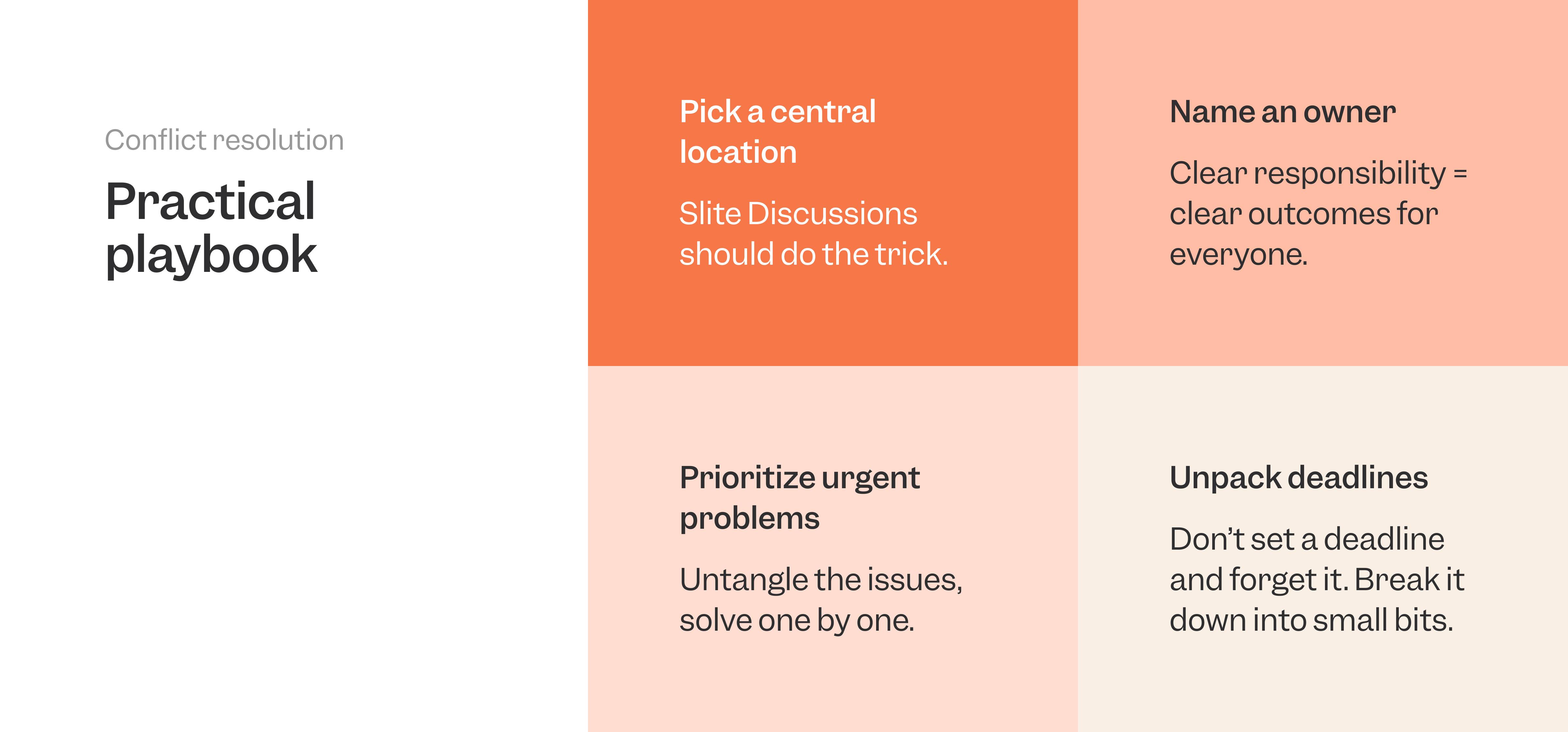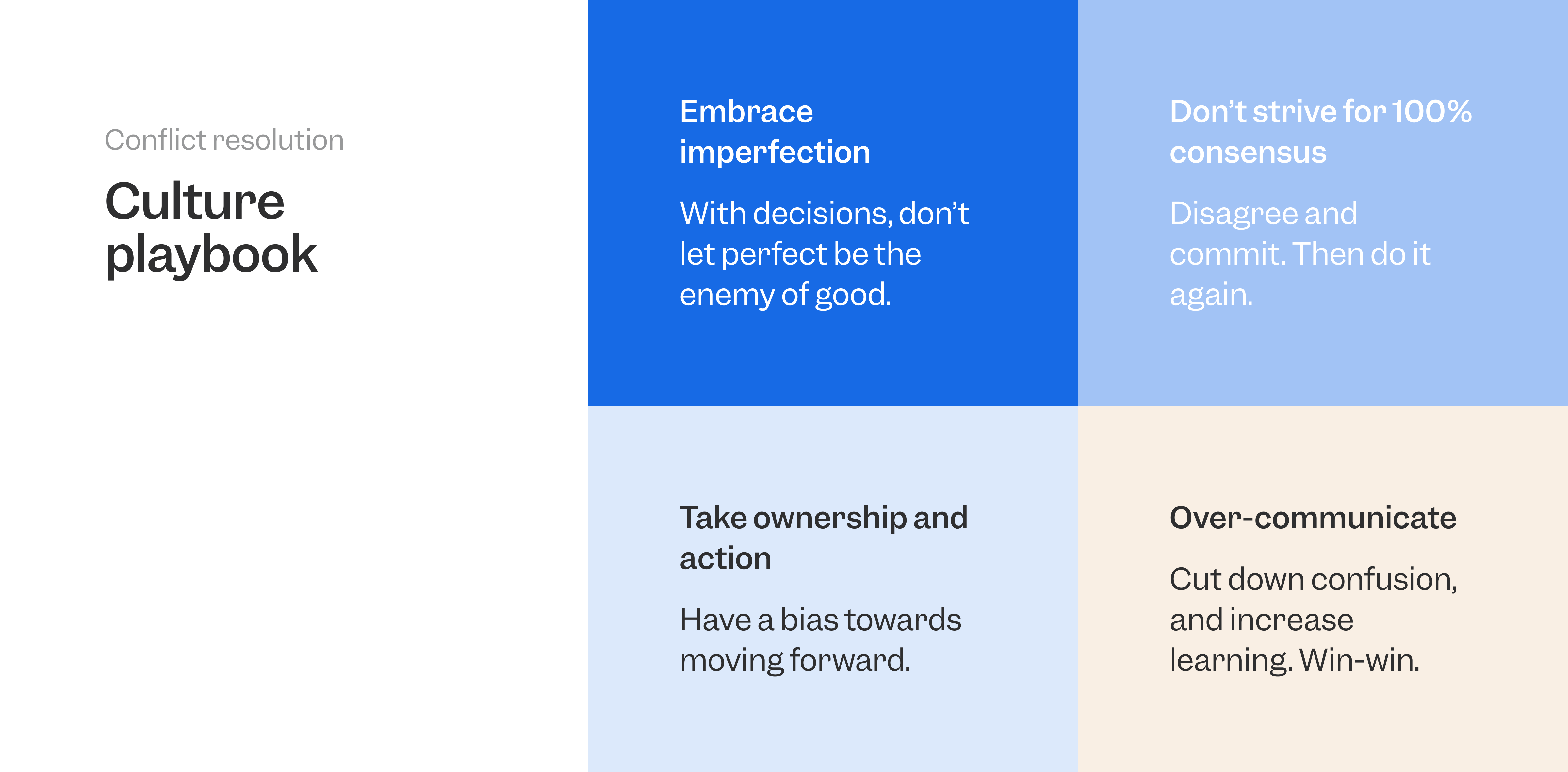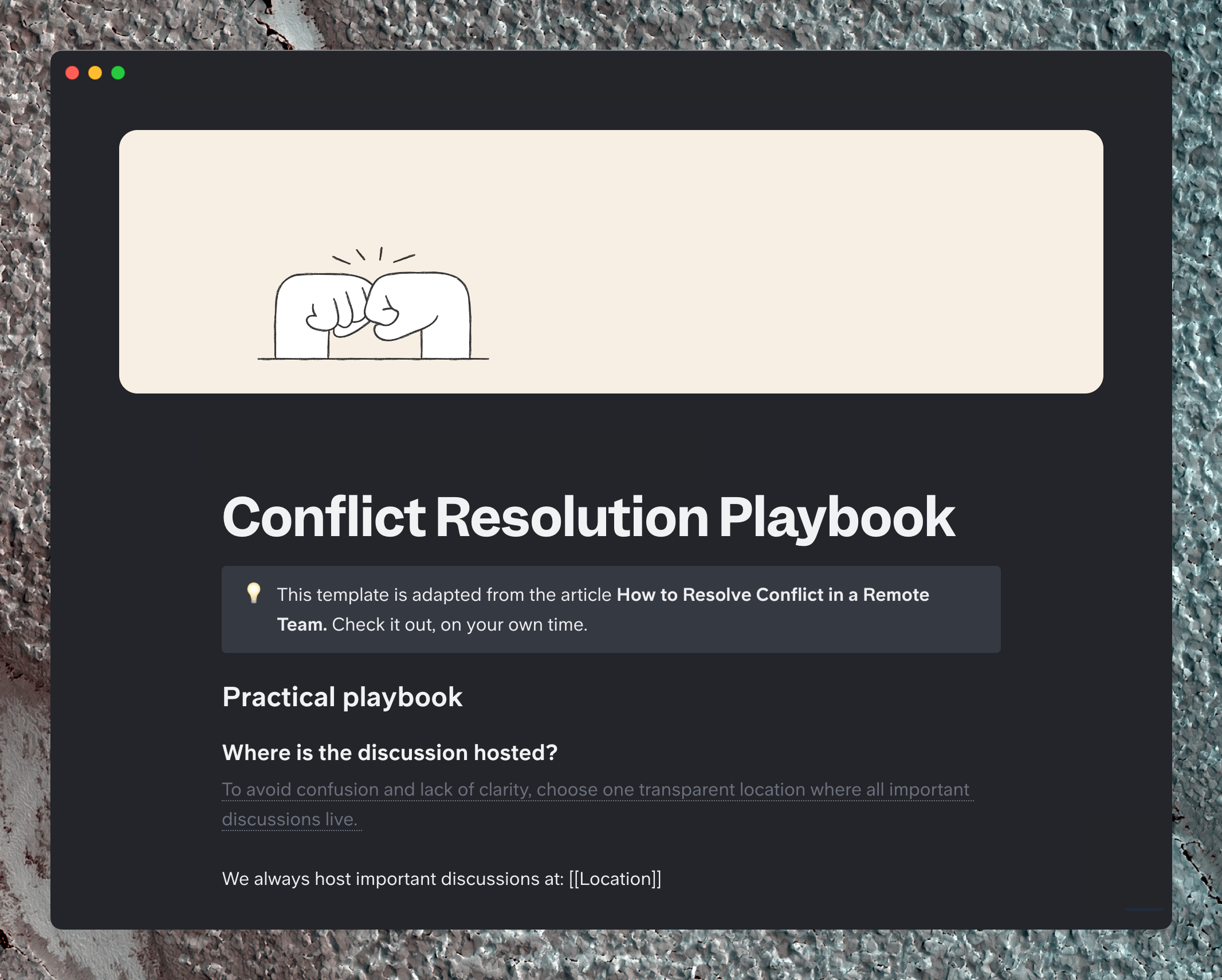How to resolve conflict in a remote team

How can we improve the user onboarding experience? Should we sunset this feature? What are the pros and cons of switching email services? Can we afford to keep hiring?
Difficult questions cause conflict, and the foundation of any company is tested during conflict. But conventional wisdom says that “talking it out” is the best way to relieve tension – which leaves remote teams feeling like they have a uniquely difficult time.
But it’s not a remote or async format that makes things difficult: it’s not having a good playbook for managing conflict. We've broken down our advice for managing conflict into two categories: practical and cultural. Because while you need to keep your tactics close, it's your culture that will get you through your most difficult moments.
The best part? You can use this guide as a template for your own knowledge base. Just scroll to the bottom of this article.
Practical playbook
It's impractical to get everyone on remote team in a call every time there’s a difference of opinion. The following plays will set you up for smooth, asynchronous conflict resolution.

Pick a central location
We practice fire drills so that one day, when disaster strikes, we can find our way to safety. Conflict resolution at work is not quite the same, but having a single place to go to (an emergency stairwell, if you will, makes the whole resolution process more efficient.
Having one central, transparent location for discussions means you can't let frustrations fefster in private comments and Slack threads. Of course, we think Slite Discussions is a good option for teams facing difficult conversations.
Name an owner
Lack of clarity about responsibility is at the core of many conflicts at work, especially in remote teams. When an owner of a project, task, or discussion is clearly named, they get the final say on how to move forward.
That doesn't mean hierarchy rules, however. The owner of a particular discussion can be:
- The one who brought the issue up in the first place
- The one who will be tasked with carrying out the solution
- The one with the most expertise in the given subject matter.
Prioritize urgent problems
Sometimes conflict arises because people are discussing more than one problem at a time. This makes the problem seem larger than it is, and it's hard to move forward.
For example, you are trying to decide what feature to prioritize next, based on your user interviews from last quarter. This might spiral into a debate as to whether or not to send out a new survey, and what questions to ask on the survey.
Untangle multiple issues by tackling the biggest question first and going from there. In this case, you need to decide if you need updated user data. If the answer is yes, start a new discussion to determine the focus of the new survey. If the answer is no, table that debate and refocus on your existing data.
Unpack deadlines
Having no deadline for a decision can lead to feelings of frustration and being stuck. But only using one deadline can cause problems, too.
Say your team gives itself two weeks to make a decision on a contract for a freelance designer. Ideas are flowing, and you draft a tentative agreement.
Then, on the day you’re going to move forward, one of your coworkers – who thrives on deadlines and pressure – gives a detailed rundown of what she would have liked during her time freelancing, and shares multiple templates that she's used for contracts in the past.
Even though she's made great comments, this colleague just delayed the decision for everyone, and you really need to hire the freelancer now.
Use multiple deadlines to avoid this type of crunch. For example, you can:
- Set a deadline for replies to a discussion
- Set another deadline for narrowing down the top 3 solutions
- Set a final deadline for deciding on the next step
Make a point of moving on with your timeline as planned.
Culture playbook
Even if your protocol is perfect, your team will have a hard time handling conflict if you don’t have a good mentality.

Embrace imperfection
If the perfect solution to a problem existed, there probably wouldn’t be any disagreements about what to do! But that’s just not realistic. Encourage people to:
- Accept that you need to make a good decision, not a perfect one.
- Remember that every problem, discussion and solution is an opportunity to learn and grow. Nobody, at any company, nails it every time.
- Think about the bigger picture of moving forward and being able to make adjustments. Don’t get hung up on the details, especially when they’re not set in stone.
Don’t strive for 100% consensus
When there’s a verbal conversation, it can feel more natural to move on from the specifics of people’s starting points to agree on a path forward. A written record of how everything has played out can make it feel more urgent to make sure everyone fully agrees.
Don’t fall into this trap. What matters isn’t having 100% consensus, it’s being able to understand why the team is going with one choice over the other and being able to get behind it.
“Disagree and commit” is a bit of a cliche in the tech space, but it’s true. If people spend too much time blocking decisions or nursing grudges, productivity and positivity will be hard to find.
Over-communicate
When having a discussion asynchronously, aim on the side of over-communicating.
Disputes can spiral out of hand when people feel removed from the decision-making process. But if you communicate often and in detail, it helps cut down on discussion time by heading off the need for multiple follow-ups.
Being thorough can also help reduce misunderstandings. Remember that Sales doesn't speak the same language as Engineering, and vice versa. Being generous with your rationale will help everyone learn.
This type of communication should be baked into your company culture already. Leadership can set an example in the way they communicate with direct reports, company-wide memos, and even investor updates.
Finally, make sure there’s a chance for everyone to check in outside of important discussions. Strong relationships can't only be forged in conflict - they have to be established in casual conversations as well.
Take ownership and take action
Discussions happen because your team needs to make a decision. Decisions get made because your team needs to move forward and get something done.
Having an ownership mentality is crucial, especially in startups. There's often no perfect owner for a task, and there's certainly no perfect owner for a disagreement. Instead, empower your team to move forward knowing that it’s more important to put in an honest effort than it is to come up with sheer brilliance in the first iteration.
Embracing imperfection, working without exact consensus and over-communicating should all lead up to this bias to action.
Download the template
Remote teams have to be willing to make things work in new and different ways. So many management techniques for disagreements rely on everyone being in one place at the same time to hash things out.
But that’s only one way to do things. With a good team culture and an established communication structure, any remote team can confidently navigate decision making from any time or place.
Adapt this playbook by adding the template to your Slite.


Written by Lauren Christiansen
Lauren Christiansen is a freelance marketer with a passion for content that helps teams work better, together. While she specializes in B2B SaaS professionally, in her spare time you can find her unplugged and hiking in the woods of New England.


